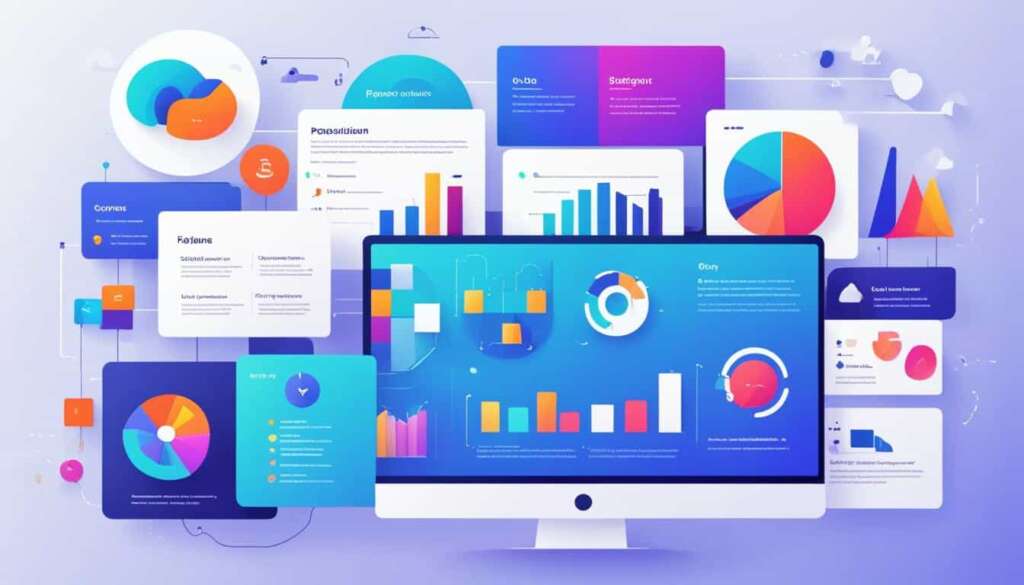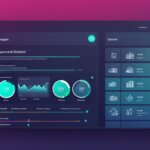Table of Contents
Presentation software, also known as graphics presentation applications or presentation graphics programs, is a category of software used to create content where information is often represented in a graphical or visual way. It helps in creating dynamic slideshows by using visual elements like pictures, charts, graphs, and other graphical representations.
There are two main types of presentation software: business presentation software and general multimedia authoring tools. Business presentation software is designed for ease of learning and use, with advanced functions available for experienced users. General multimedia authoring software allows users to create sophisticated presentations with a wide range of visual elements like photos, icons, audio narrations, transitions, animations, and video sequences.
Presentation software often includes templates, cloud-based collaboration features, a library of images and other visual elements, and integration with external sources for images and videos. It can also incorporate artificial intelligence for quick and automated presentation generation.
Continue reading Key Features and Benefits of Presentation Software
Key Features and Benefits of Presentation Software
Presentation software provides various key features to enhance the user experience. One of the main features is the availability of templates that can be easily edited to match user requirements or company brand guidelines. The software also includes a search feature for discovering templates, layouts, and previous presentations.
“Templates are a valuable resource for users, offering pre-designed layouts and designs that can be customized to create visually stunning presentations. They save time and effort by providing a starting point for the content creation process.”
Cloud-based presentation applications offer shared workspaces and team folders for secure collaboration, real-time sharing of presentations, versioning capabilities, and integration with external image sources like Unsplash and Giphy. Some presentation software integrates with external video sites like YouTube or Vimeo, allowing users to embed videos in their presentations.
“Collaboration features enable teams to work together seamlessly, improving productivity and ensuring a smooth workflow. Real-time sharing and versioning capabilities allow multiple users to collaborate on the same presentation, making teamwork easier than ever.”
AI-powered presentation products include conversational AI engines that can generate new presentations based on user input and descriptions. They may also have built-in designers that automatically convert content into visually rich slides based on predefined design rules.
“Artificial intelligence takes presentation creation to the next level by offering automated solutions. AI-powered designers can analyze the content and generate visually appealing slides tailored to brand esthetics, saving users time and effort.”
Additionally, the best presentation software supports brand esthetics by updating every slide and deck with specific fonts, colors, logos, themes, and templates to create consistent brand presentations.
“Brand consistency is crucial for maintaining a professional image. With customizable brand esthetics, presentation software helps businesses create visual representations that align with their brand identity, fostering brand recognition and trust.”
Let’s take a closer look at the benefits of presentation software features:
| Feature | Benefits |
|---|---|
| Templates | Save time and effort in content creation Ensure visually appealing designs Consistent brand representation |
| Collaboration | Enhance teamwork and productivity Real-time sharing and versioning Seamless collaboration on presentations |
| Artificial Intelligence | Automate presentation creation Create visually rich slides with minimal effort Customize design based on predefined rules |
| Brand Esthetics | Maintain consistent brand identity Create visually appealing brand presentations Build trust and brand recognition |
Unlocking Creativity with Templates
Templates empower users to unleash their creative potential. By providing ready-made layouts and designs, templates offer a starting point for content creation. Users can customize templates to suit their specific needs and brand esthetics, resulting in visually stunning presentations that captivate audiences.
Seamless Collaboration for Effortless teamwork
The collaboration features of presentation software allow teams to collaborate seamlessly on presentations. Shared workspaces, real-time sharing, and versioning capabilities ensure that all team members stay on the same page. This enhances productivity, reduces communication barriers, and promotes efficient teamwork.
The Power of Artificial Intelligence in Presentation Creation
Artificial intelligence revolutionizes presentation creation by automating various aspects of the process. AI-powered conversational agents can generate new presentations based on user input and descriptions, saving time and effort. Built-in designers powered by AI analyze content and automatically create visually rich slides, ensuring a professional and polished final product.
Brand Consistency for a Strong Identity
Presentation software enables businesses to maintain consistent brand identity. By updating every slide and deck with specific fonts, colors, logos, themes, and templates, organizations can ensure that their presentations align with their brand esthetics. This fosters brand recognition, builds trust, and establishes a strong visual identity.
Common Applications and Popular Products of Presentation Software
Presentation software is widely used in various applications such as creating creative briefs, pitch decks, moodboards, competitor analyses, proposals, project reports, marketing plans, and meeting discussions. It allows users to combine text, animations, images, video, audio, and transitions to create visually engaging presentations.
One of the most popular presentation software applications is Microsoft PowerPoint, known for its user-friendly features. It offers extensive design options, easy sharing and collaboration capabilities, and seamless integration with multimedia elements. Another popular choice is Google Slides, which provides online collaboration, real-time editing, and cloud storage for easy access from anywhere. Prezi is a dynamic presentation tool that uses the concept of zooming and panning to create captivating visual experiences.
Other notable products in the presentation software market include Slidebean, Canva, and Keynote. These products cater to different user preferences and platforms, with versions available for both PC and Mac. Some presentation software options are available for free, while others offer additional features and advanced functionalities in paid or freemium versions.
When selecting presentation software, it is essential for individuals and organizations to consider specific requirements, technical compatibility, target audience, and budgetary constraints. By choosing the most suitable presentation software, users can effectively convey their ideas, enhance communication, and leave a lasting impact on their audiences.
FAQ
What is presentation software?
Presentation software, also known as graphics presentation applications or presentation graphics programs, is a category of software used to create content where information is often represented in a graphical or visual way. It helps in creating dynamic slideshows by using visual elements like pictures, charts, graphs, and other graphical representations.
What are the types of presentation software?
There are two main types of presentation software: business presentation software and general multimedia authoring tools. Business presentation software is designed for ease of learning and use, with advanced functions available for experienced users. General multimedia authoring software allows users to create sophisticated presentations with a wide range of visual elements like photos, icons, audio narrations, transitions, animations, and video sequences.
What features does presentation software offer?
Presentation software provides various key features to enhance the user experience. One of the main features is the availability of templates that can be easily edited to match user requirements or company brand guidelines. The software also includes a search feature for discovering templates, layouts, and previous presentations. Cloud-based presentation applications offer shared workspaces and team folders for secure collaboration, real-time sharing of presentations, versioning capabilities, and integration with external image sources like Unsplash and Giphy. Some presentation software integrates with external video sites like YouTube or Vimeo, allowing users to embed videos in their presentations. AI-powered presentation products include conversational AI engines that can generate new presentations based on user input and descriptions. They may also have built-in designers that automatically convert content into visually rich slides based on predefined design rules. Additionally, the best presentation software supports brand esthetics by updating every slide and deck with specific fonts, colors, logos, themes, and templates to create consistent brand presentations.
What are the common applications of presentation software and popular products?
Presentation software is widely used in various applications such as creating creative briefs, pitch decks, moodboards, competitor analyses, proposals, project reports, marketing plans, and meeting discussions. Microsoft PowerPoint is one of the most popular presentation software applications available today, offering user-friendly features for design, sharing, collaboration, and multimedia integration. Other popular products include Google Slides, Prezi, Slidebean, Canva, and Keynote. These products offer both PC and Mac versions, with some available for free download and use, while others come in free, paid, or freemium versions. When selecting presentation software, organizations and users should consider their specific requirements, technical stack, audience type, and budget to ensure they choose the most suitable software for their needs.












